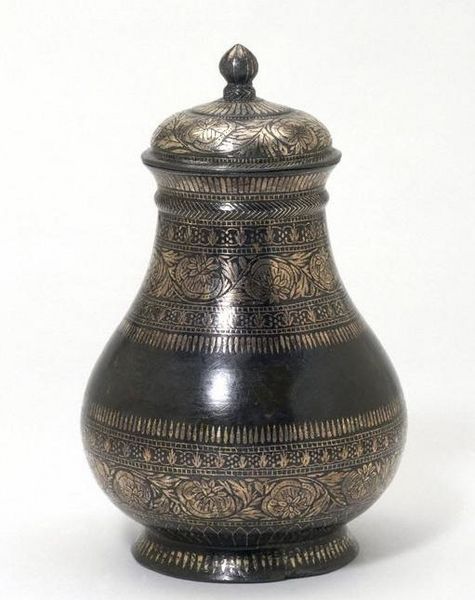Image: Bidriware cup and lid, ca 1850 V&A Museum

Description: Cup with lid, bidriware, about 1850 V&A Museum no. 151&A-1852 Techniques - Blackened zinc alloy overlaid with silver (bidri) Artist/designer - Unknown Place - Bidar, India Dimensions - Height 13 cm Width 10 cm Object Type - Bidri ware seems to have been made by Muslim metalworkers of the Deccan in the Indian subcontinent by the early 17th century, using a technique known only in that part of the world. Throughout the 17th century bidri craftsmen made finely crafted wares from a blackened zinc alloy inlaid with silver and brass. These were probably intended for a narrow luxury market in the Deccan, the Mughal empire and Safavid Persia (now Iran). Demand increased through the 18th and 19th centuries, and by the mid-19th century this had affected the quality of the wares. Shapes were increasingly influenced by European forms, as seen in this cup and cover. The simplicity of the design of the silver decoration on this piece illustrates the move towards patterns that could be quickly, and therefore cheaply, produced. Materials & Making - The term bidri derives from the name of the historic Deccan city of Bidar, now in Karnatika, where the technique is thought to have developed. Material evidence of this technique first appears in the 17th century, though the number of surviving pieces is small. Bidri objects are cast from an alloy of zinc, usually with small amounts of lead, copper and tin. The surface of the object is made smooth and is darkened temporarily with a solution of copper sulphate; a design is then engraved on the surface to expose the silvery grey of the alloy. The inlayer then hammers silver into the engraved lines or cavities, after which the object is given a final matt black surface that contrasts with the silver design. This is done by applying a paste of mud mixed with ammonium chloride, potassium nitrate, sodium chloride and copper sulphate. The mud is removed, and finally oil is rubbed into the piece to deepen the black hue. Historical Associations - The cup and cover were acquired from the Great Exhibition in London in 1851. This exhibition brought to the attention of an international audience the richness of India's decorative traditions, and allowed the subcontinent's sophisticated metalwares to be appreciated for the first time. Bidri ware found a vastly increased market after being shown at the Great Exhibition and the International Exhibition in Paris in 1855. This led to new production centres being established. Motifs drawn from the bidri shown at both exhibitions were reproduced by the British architect and designer Owen Jones (1809-1874) in his book The Grammar of Ornament.
Title: Bidriware cup and lid, ca 1850 V&A Museum
Credit: http://images.vam.ac.uk/indexplus/page/Home.html
Author: VAwebteam at English Wikipedia
Usage Terms: GNU Free Documentation License
License: GFDL
License Link: http://www.gnu.org/copyleft/fdl.html
Attribution Required?: Yes
Image usage
There are no pages that link to this image.

